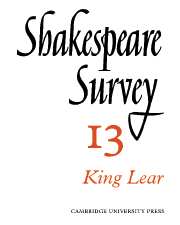Book contents
- Frontmatter
- The Catharsis of King Lear
- Lear’s Last Speech
- Albany
- Madness in King Lear
- The Influence of Gorboduc on King Lear
- Some Aspects of the Style of King Lear
- Keats and King Lear
- King Lear on the Stage: A Producer’s Reflections
- Costume in King Lear
- The Marriage-Contracts in Measure for Measure
- Tom Skelton—A Seventeenth-century Jester
- Illustrations of Social Life III: Street-Cries
- An Elizabethan Stage Drawing?
- Was there a Music-room in Shakespeare’s Globe?
- International Notes
- Shakespeare Productions in the United Kingdom: 1958
- Three Adaptations
- The Year's Contributions to Shakespearian Study 1 Critical Studies
- 2 Shakespeare’s Life, Times and Stage
- 3 Textual Studies
- Books Received
- Index
- Plate Section
Was there a Music-room in Shakespeare’s Globe?
Published online by Cambridge University Press: 28 March 2007
- Frontmatter
- The Catharsis of King Lear
- Lear’s Last Speech
- Albany
- Madness in King Lear
- The Influence of Gorboduc on King Lear
- Some Aspects of the Style of King Lear
- Keats and King Lear
- King Lear on the Stage: A Producer’s Reflections
- Costume in King Lear
- The Marriage-Contracts in Measure for Measure
- Tom Skelton—A Seventeenth-century Jester
- Illustrations of Social Life III: Street-Cries
- An Elizabethan Stage Drawing?
- Was there a Music-room in Shakespeare’s Globe?
- International Notes
- Shakespeare Productions in the United Kingdom: 1958
- Three Adaptations
- The Year's Contributions to Shakespearian Study 1 Critical Studies
- 2 Shakespeare’s Life, Times and Stage
- 3 Textual Studies
- Books Received
- Index
- Plate Section
Summary
The first historian to deal with the problem of a music-room in the Elizabethan theatre appears to have been Edmund Malone. Writing in 1790, Malone said: ‘The band . . . sat (as I have been told by a very ancient stage veteran, who had his information from Bowman, the contemporary of Betterton) in an upper balcony, over what is now called the stage-box’ (‘An Historical Account of the Rise and Progress of the English Stage’, in The Malone-Boswell Variorum Shakespeare, 1821, III, 111–12). The words quoted, however, contain an obvious error, as W. J. Lawrence pointed out in 1911:
Unfortunately, Malone did not know, what is well known now, that the Elizabethan theatre, unlike the theatre of his own time, had neither proscenium arch nor front curtain; otherwise he would not have conveyed his information in precisely these terms. The stage boxes in the latter half of the eighteenth century were situated on either side of the ‘apron,’ or avant scène, a little in front of the proscenium arch. It is at least made clear to us, however, by Malone that the ancient ‘music-room’ was in stage regions and not in the auditorium proper. Most likely, what Bowman’s acquaintance meant to convey to him was that the Elizabethan musicians occupied an upper balcony at the back of the stage. Broadly speaking, this tallies with most of the evidence educible on the subject.
- Type
- Chapter
- Information
- Shakespeare Survey , pp. 113 - 123Publisher: Cambridge University PressPrint publication year: 1960

